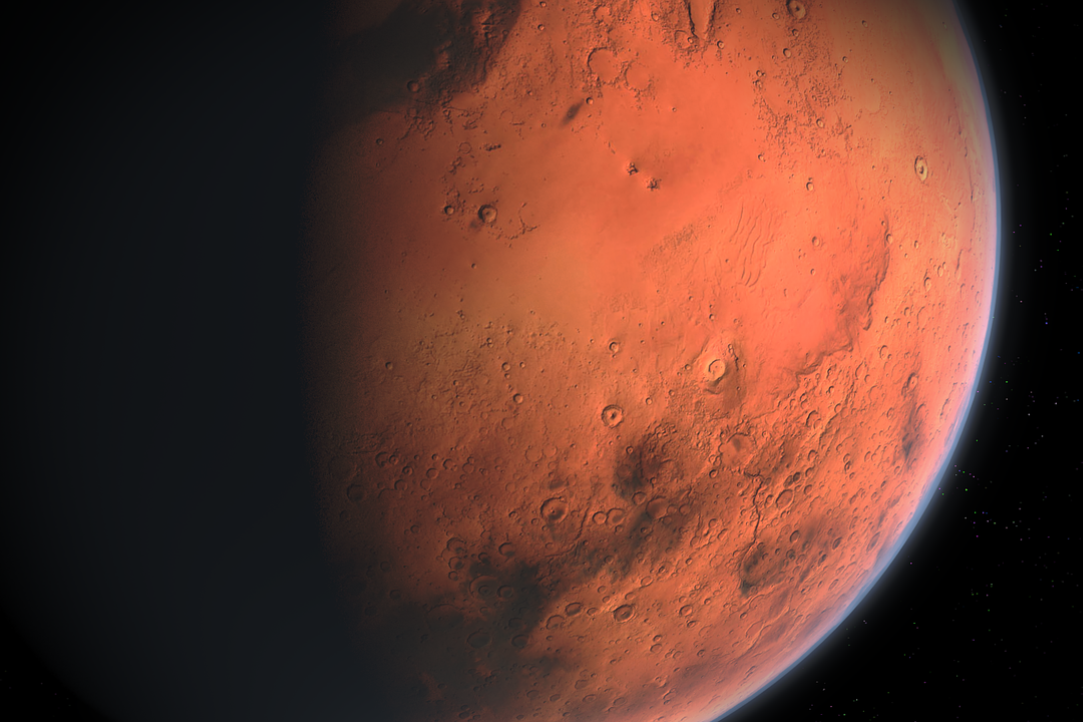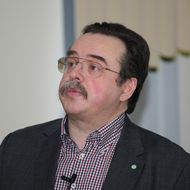Researchers Begin to Understand Correlation of Schumann Resonances and Dust Storms on Mars

The interaction of dust particles in Martian dust storms may cause electric fields that are powerful enough to have charges that induce standing electromagnetic waves known as Sсhumann resonances. This is the conclusion drawn by physicists from HSE University, the Space Research Institute, and MIPT. The paper was published in Icarus journal.
Mars has been a focus of active study over the last decade, with researchers looking at possible space missions to the planet. Knowledge about the Martian atmosphere increases the chances that such missions will be successful. In particular, the behaviour of dust particles and the plasma-dust system on the surface of Mars should be taken into account in planning space trips.
In 2009, a 34 m radio telescope of NASA’s Deep Space Network registered a non-thermal microwave radiation during a Martian dust storm. In the observed radiation spectrum, attributes of Schumann resonances were detected at frequencies of 7.83 Hz, 14.1 Hz, and 20.3 Hz.
Researchers from HSE University, the Space Research Institute and MIPT looked at the role of dust and dust plasma in the excitement of ultra-low-frequency (below 100 kHz) standing electromagnetic waves on Mars. Since the mid-1950s, this phenomenon has been known as Schumann resonances, after Otto Schumann, an Austrian scholar who was the first to study standing electromagnetic waves in an Earth-ionosphere resonator.
For electromagnetic waves, the Earth and its ionosphere are a huge spherical resonator, with its cavity filled with a weakly electrically conductive medium. If an electromagnetic wave that evolves in this medium goes around the Earth and resonates itself, it can exist for a long time.
Schumann resonances on Earth are presumably caused by thunderstorm charges in the spherical cavity between the planet’s surface and the lower layers of the ionosphere.

Sergey Popel, Professor at the HSE Faculty of Physics, Laboratory Head at RAS Space Research Institute
‘Lightning activity is related to average temperature on Earth. Observations also confirm a correlation between the temperature and the amplitudes of Schumann resonances on Earth. This data has become a foundation for our studies of similar phenomena on Mars.’
The scholars analysed the mechanism that ensures the loading of power in the Schumann resonator. It turned out that electrical discharges are a ‘good candidate’. But these electrical discharges have a different nature as compared to Earthly lightnings. Lightnings in their Earthly understanding are not typical for Martian atmosphere in which dust swirls, also called ‘dust devils’, are widespread. They are small storms measuring about 100 m in diameter that last several minutes. That’s why there are no analogues to Earthly meteorological clouds in the rare and dry Martian atmosphere, but dust phenomena play an important role.
The process of charging the dust particles in the Martian atmosphere has similarities with the processes that take place in volcanic clouds on Earth: two particles consisting of the same material collide, and the smaller one gets a negative charge, while the bigger one charges positive. Under gravity, the heavier positively charged particles gather in the lower parts of dust swirls, while lighter negatively charged particles remain in the upper part. Charges separate, which may lead to electrical discharge.
However, the authors of the paper state that as of yet there is no unambiguous experimental evidence that would confirm the existence of electric discharges in the atmosphere of Mars. Orbital modules that study Mars usually study the upper layers of the atmosphere, while the lower layer remains outside their monitoring zone. To know for sure whether there are Schumann resonances on Mars, the electric fields on the surface of the planet need to be measured.
‘Ideally, we should measure the amplitude of Schumann oscillations and understand whether there is a correlation between changing amplitudes of Schumann resonances and the changes in intensity of dust storms on Mars,’ Sergey Popel said. ‘But to do it, we would need some highly sensitive equipment.’
No such projects have been planned yet, but the second stage of ExoMars mission, which is scheduled for the latter half of 2022, will probably contribute to these studies.
See also:
Physicists Propose New Mechanism to Enhance Superconductivity with 'Quantum Glue'
A team of researchers, including scientists from HSE MIEM, has demonstrated that defects in a material can enhance, rather than hinder, superconductivity. This occurs through interaction between defective and cleaner regions, which creates a 'quantum glue'—a uniform component that binds distinct superconducting regions into a single network. Calculations confirm that this mechanism could aid in developing superconductors that operate at higher temperatures. The study has been published in Communications Physics.
'Even among Geniuses, Luck Plays a Role in Winning a Nobel Prize'
Denis Bodrov studies particle physics and works at one of the four electron–positron colliders in the world. In this interview with the HSE Young Scientists project, he talks about his efforts to go beyond the Standard Model, discusses tau leptons, and shares his affection for Moscow.
Physicists at HSE University Reveal How Vortices Behave in Two-Dimensional Turbulence
Researchers from the Landau Institute for Theoretical Physics of the Russian Academy of Sciences and the HSE University's Faculty of Physics have discovered how external forces affect the behaviour of turbulent flows. The scientists showed that even a small external torque can stabilise the system and extend the lifetime of large vortices. These findings may improve the accuracy of models of atmospheric and oceanic circulation. The paper has been published in Physics of Fluids.
New Method for Describing Graphene Simplifies Analysis of Nanomaterials
An international team, including scientists from HSE University, has proposed a new mathematical method to analyse the structure of graphene. The scientists demonstrated that the characteristics of a graphene lattice can be represented using a three-step random walk model of a particle. This approach allows the lattice to be described more quickly and without cumbersome calculations. The study has been published in Journal of Physics A: Mathematical and Theoretical.
‘It Was Interesting to See How Our Chinese Colleagues Work’: HSE Researchers Take Part in Hefei Summer School
This summer, Diana Sukhoverkhova, Daria Mazur, and David Kagramanyan, research assistants at the MIEM HSE Laboratory for Computational Physics, spent five weeks in China. At the Future Scientist Exchange Program (FuSEP) summer school in Hefei, they worked in new fields of science together with their Chinese colleagues. HSE's promising scientists spoke to the HSE News Service about their intense and productive time in China.
‘The Fundamental Principle of Scientific Knowledge Is Honesty’
Daria Mazur has wanted to pursue science since she was 13 years old—ever since she discovered in the seventh grade that she was good at physics. In an interview for the HSE Young Scientists project, she spoke about her theoretical research on the electric double layer, speed reading, and the MGMT song ‘Little Dark Age.’
Russian Scientists Reconstruct Dynamics of Brain Neuron Model Using Neural Network
Researchers from HSE University in Nizhny Novgorod have shown that a neural network can reconstruct the dynamics of a brain neuron model using just a single set of measurements, such as recordings of its electrical activity. The developed neural network was trained to reconstruct the system's full dynamics and predict its behaviour under changing conditions. This method enables the investigation of complex biological processes, even when not all necessary measurements are available. The study has been published in Chaos, Solitons & Fractals.
Russian Physicists Discover Method to Increase Number of Atoms in Quantum Sensors
Physicists from the Institute of Spectroscopy of the Russian Academy of Sciences and HSE University have successfully trapped rubidium-87 atoms for over four seconds. Their method can help improve the accuracy of quantum sensors, where both the number of trapped atoms and the trapping time are crucial. Such quantum systems are used to study dark matter, refine navigation systems, and aid in mineral exploration. The study findings have been published in the Journal of Experimental and Theoretical Physics Letters.
Russian Scientists Demonstrate How Disorder Contributes to Emergence of Unusual Superconductivity
Researchers at HSE University and MIPT have investigated how the composition of electrons in a superconductor influences the emergence of intertype superconductivity—a unique state in which superconductors display unusual properties. It was previously believed that intertype superconductivity occurs only in materials with minimal impurities. However, the scientists discovered that the region of intertype superconductivity not only persists but can also expand in materials with a high concentration of impurities and defects. In the future, these superconductors could contribute to the development of highly sensitive sensors and detectors. The study has been published in Frontiers of Physics.
Scientists at HSE University Devise More Accurate Method for Predicting the Electrical Conductivity of Electrolyte Solutions
Researchers at HSE MIEM have developed a model for calculating the electrical conductivity of aqueous electrolyte solutions; for the first time, it considers the spatial distribution of ion charges instead of assuming their localisation at a single point. The model remains effective even at high electrolyte concentrations and across a wide temperature range. This breakthrough will contribute to the development of more efficient batteries and enable the calculation of electrical conductivity without the need for experimental testing. The study has been published in the Journal of Chemical Physics.


